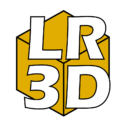VirtuMall
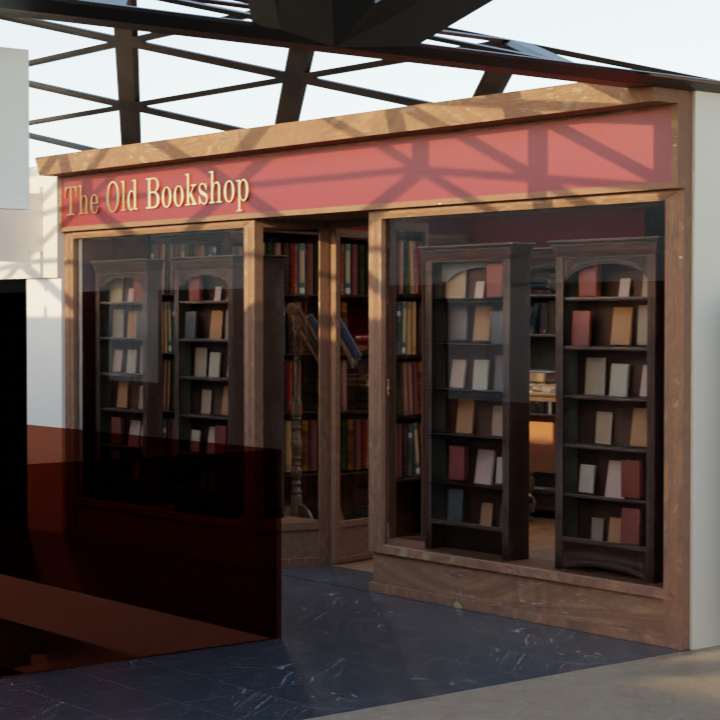
Introduction
The metaverse and the non-gaming side of the VR industry are emerging but still very much in their adolescents. Compelling experiences outside of gaming that properly utilise the new format are only just starting to surface, like Noun Town, for example, which uses encounters with NPCs and objects in 3D environments to teach languages. Or Horizon Workrooms which use interaction in 3D environments to enhance collaborative working. I believe there are many more ways to apply VR 3D environments that are not receiving enough attention or need further development. The one that will be addressed with this project is the prospect of VR online shopping, and I’ll be approaching that from an eCommerce platform perspective.
The Concept
The Problem
The problem I identified through my research is that online shopping can’t provoke the same kind of emotional response that traditional physical shops achieve. This is because of traditional shops’ use of explorable shop environments. eCommerce is designed to put efficiency and cost-effectiveness above everything else. These are important factors and show how eCommerce will never become obsolete, but the factor that eCommerce falls short of is a memorable experience.
Traditional shops use environment layouts, store identity, and closer connections to the product through increased interaction to boost the positive experience, and purchase intention. On the other hand, most eCommerce platforms like eBay or Amazon resemble dull documents with white backgrounds and black text, with only the platforms’ brand identities represented, which causes only the platforms’ influence over the customer to grow, and not the shop selling the product.
The Solution
To find a solution to these issues, I believe we must look toward 3D environments within VR as well as provide sellers with more control and more focus visually. This means shop owners will be able to apply their personality and brand identity to all aspects of their shopping experience, as well as allow them to create a unique store layout, presenting products using 3D models of shelves and decorations.
Effective 3D environments will cause curiosity, which will lead the consumer to explore and interact, potentially causing a positive emotional response, which finally results in them considering additional products that they’ve viewed, as well as influencing them to return.
It also should be prioritised to search by store rather than by product. This is less efficient, but it will increase patronage by the customer towards the store as well as provide a more effective browsing experience.
These solutions are strongly supported by the success of the city of Winchester’s high street. Winchester is unique in its abundance of small, independent, and boutique-style shops which utilise charm and the shop’s personality. This is why Winchester’s Centre can stay popular and vibrant while other towns and cities’ shopping districts are dying out.
My target audience will initially be VR enthusiasts who likely have access to the hardware required to access VR 3D environments. Still, as VR becomes more mainstream, my main target audience will be those who enjoy making a shopping trip into an experience. This target audience is quite nonspecific and cannot be broken down by gender or other broad categories like that, other than maybe identifying them as “consumerists”.
VirtuMall
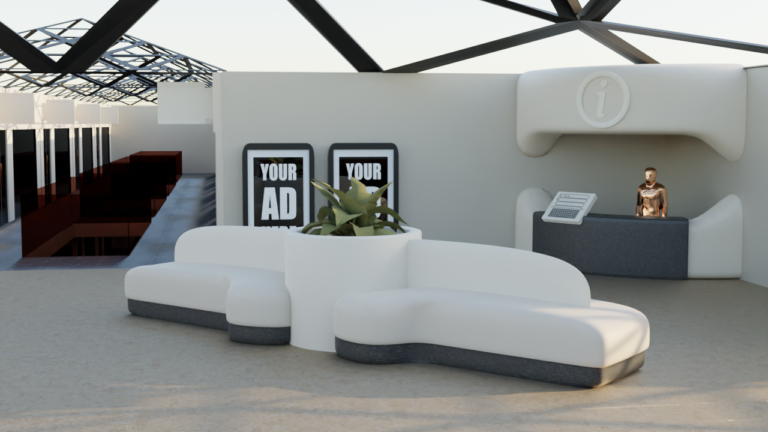
Around the user are corridors on each of the four walls, and information desks in some of the corners. You’ll also notice the ad space, which I will discuss later. In a working version of VirtuMall, by default, when you load in, these shops will be filled with a variety of shops generated by an algorithm based on your interests. The user begins on the top floor and descends as walking downstairs feels more effortless than walking up and will encourage further exploration. The “descending” approach also mirrors a “feed” for posts on social media or products on traditional eCommerce.
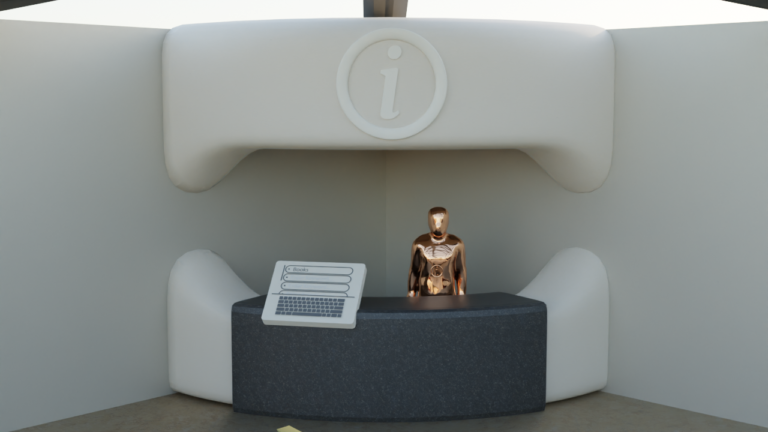
The user approaches the information desk and sees a mannequin-like figure and a screen. “Books” is entered into the key-words search, and there is space for more keywords to be entered. Approaching the AI assistant allows the user to ask questions about products, stores or the VirtuMall software in general. Now that a keyword has been entered, it’s time to find a shop. In a working version of VirtuMall, at this point, the shopping centre would be fully populated with bookstores or any other types of book-related stores.

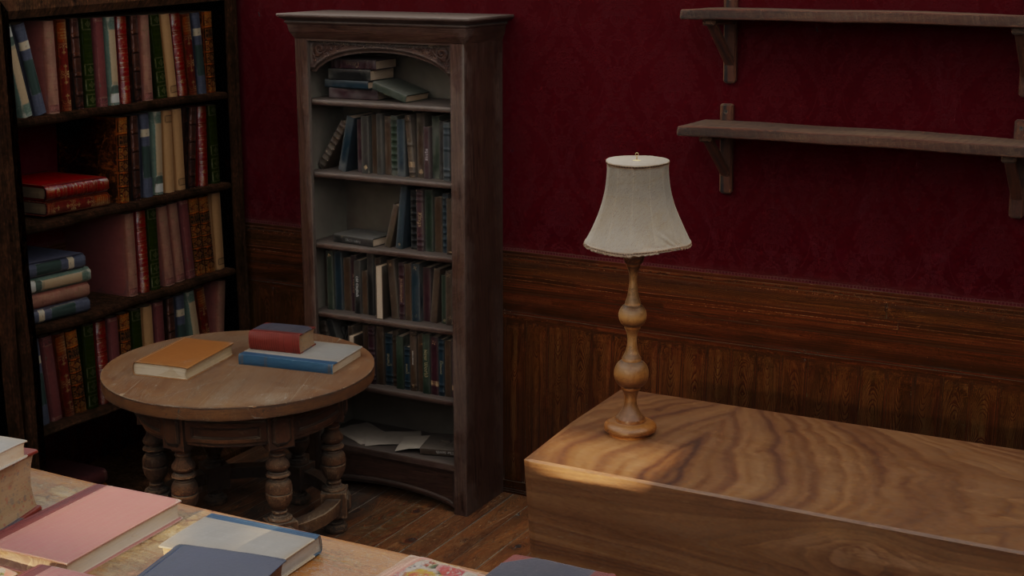
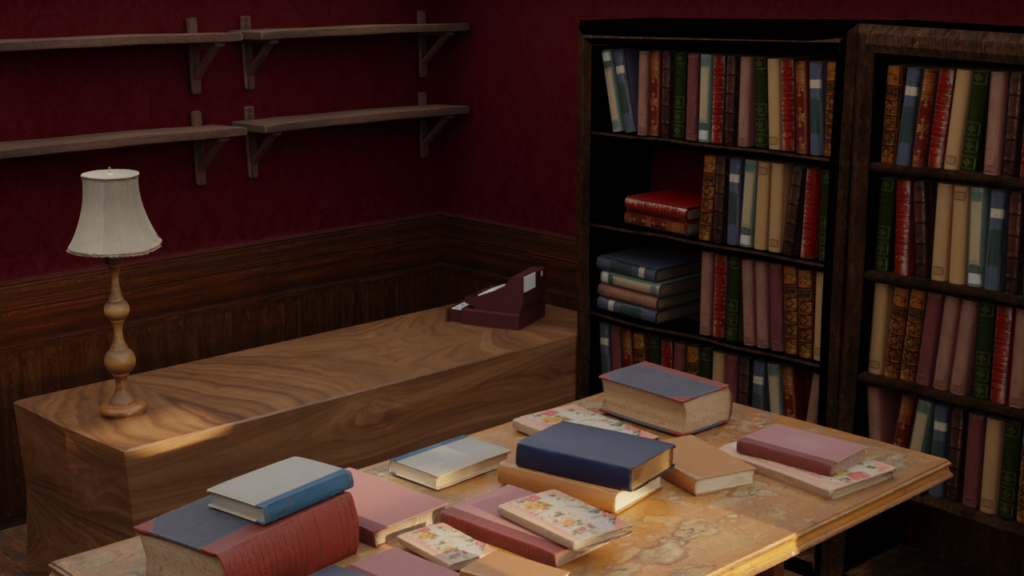
The store owner has had the opportunity to purchase this shop space and fully customise it using a built-in shop environment editor. They source 3D assets using a built-in NFT marketplace where others could create furniture and decoration assets and sell them on an open market. Alternatively, shop owners can use the platform to contact a 3D artist directly and commission something specific. If the seller has the skill set, they can produce the models with 3D software. The concept video only illustrates the core customer experience, but I felt it was important to include for context. The shop owner can present different products in different ways. For example, in the context of a bookstore, they can have most of their stock displayed compactly, on shelves along the store’s walls, or they can highlight specific books by displaying them openly on a table.
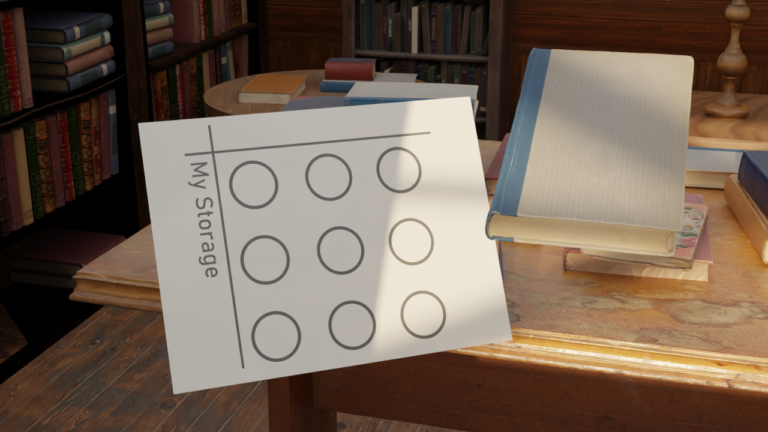
The user can pick up items to inspect them and open their storage to store the item. The storage is inspired by video game inventory systems found in VR and non-VR games alike, as it applies well to the format. (Storage design not final)
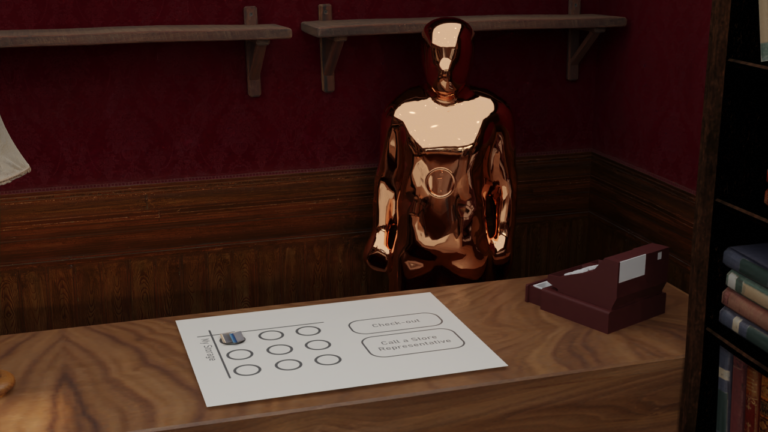
When the user has finished browsing items, they navigate to the store’s front counter, and, if they have no further questions or issues, they start the checkout process. If they need help with finding an item, delivery details or anything else, they would press the “Call a representative button”. The shop owner will have the option to assign themselves or someone else as a store representative, and they will be available “on call” whenever they choose to be. When they are absent, they will be replaced by an AI representative who will have been fed information about the store by its owner.
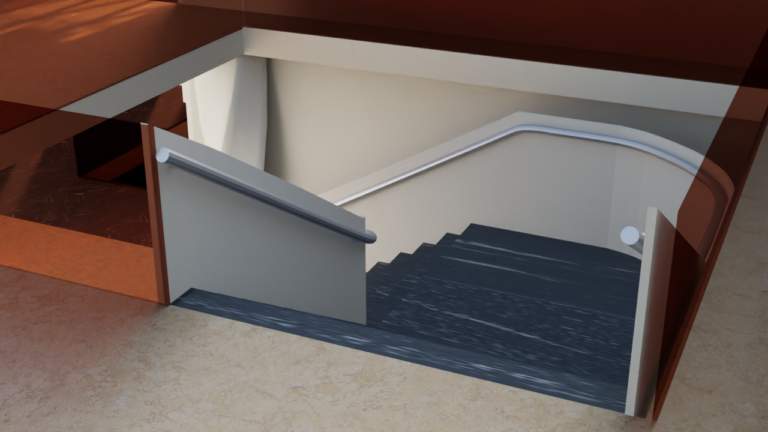
The user then leaves the store and navigates downstairs, leading to the socialising section of the concept.
Socialising

Sociability will be a key unique selling point that VR can effectively add to the online shopping experience. This is an example of social space in VirtuMall. When viewing your shopping centre alone, these areas will essentially be aesthetic only, but that changes when you get other people involved. VirtuMall will allow you to invite friends and family to your shopping centre and allow you to shop in groups. As well as this, you will have the ability to join community shopping centres for specific subjects or categories. To use the example of book shopping again, the user would join a “book” community shopping centre populated completely with bookstores, and other book shoppers will be visible and engageable. In this scenario, these social areas would be used to discuss books and receive recommendations and tips from other reading fans.
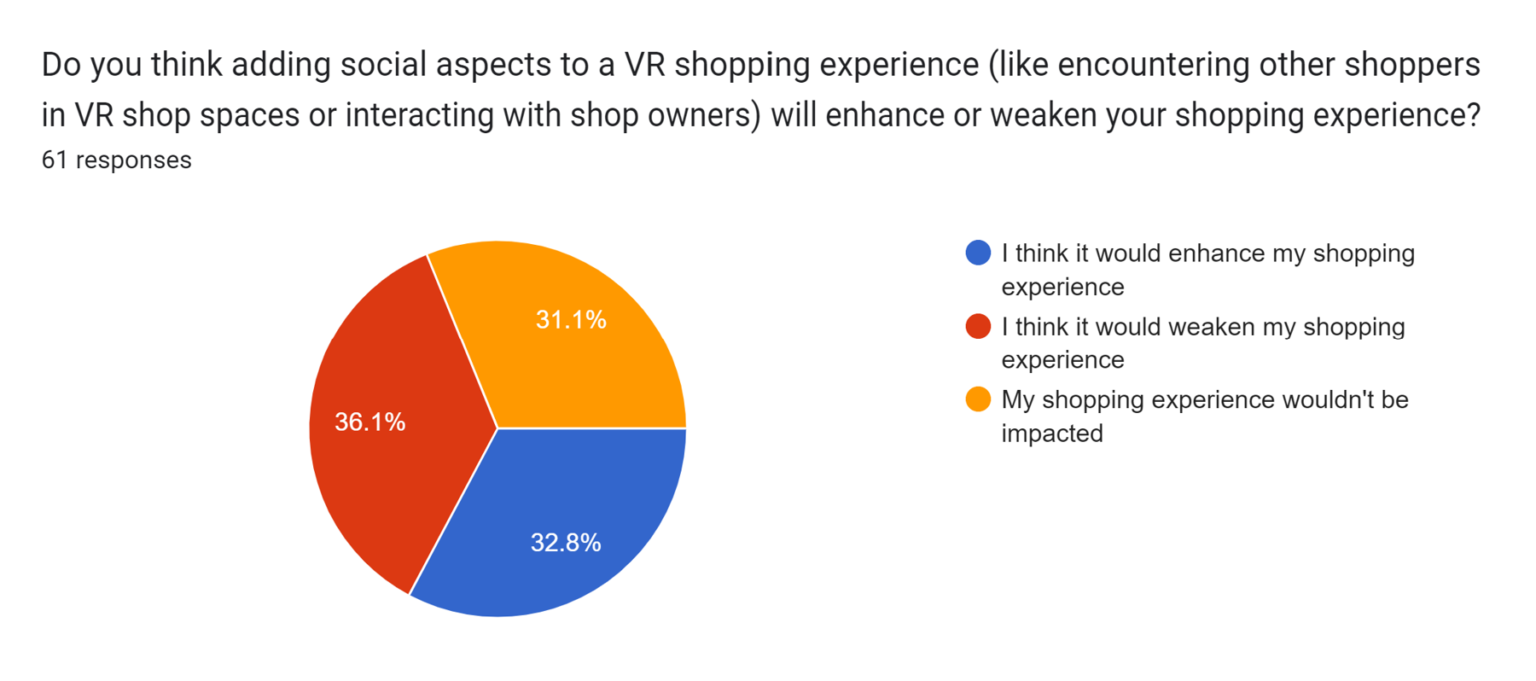
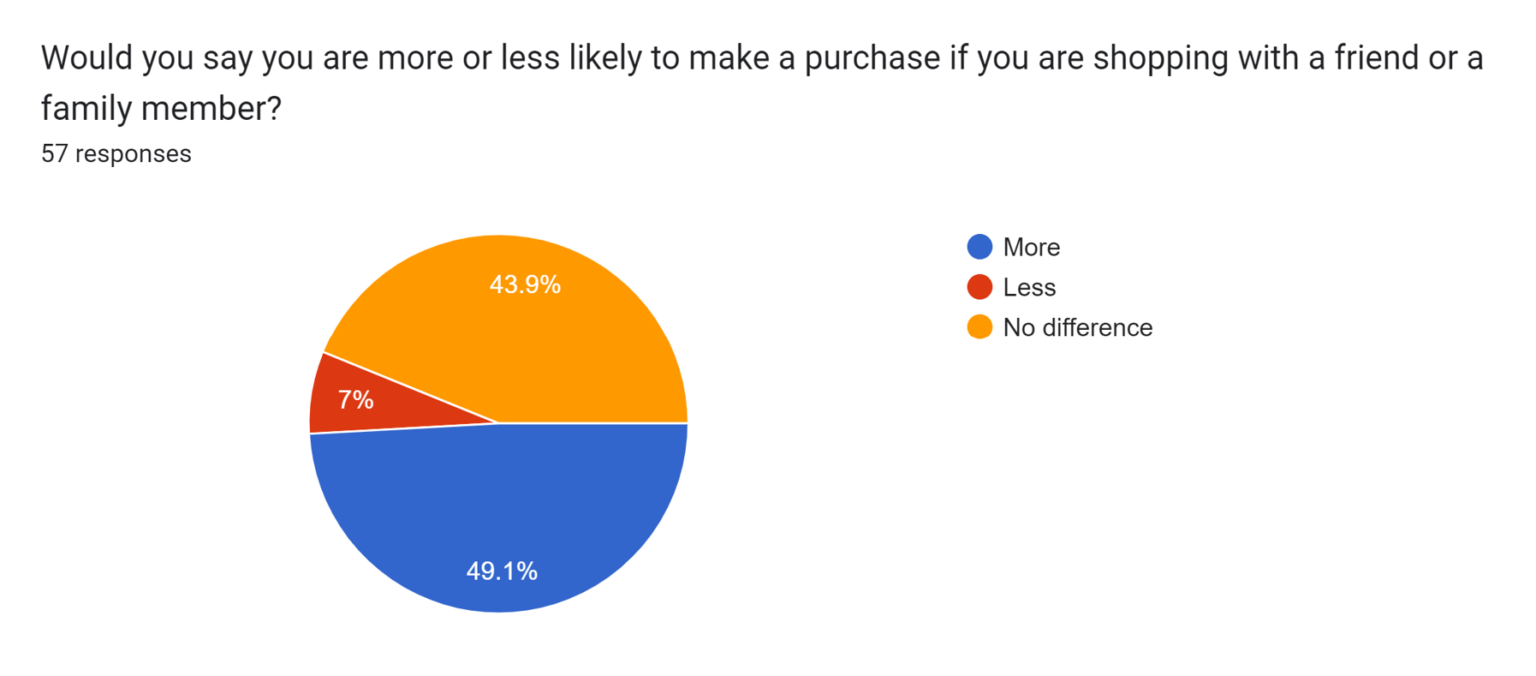
During the research, I found that adding social aspects to online shopping is a divisive subject, with a relatively even split between those who believed it would improve their experience, worsen their experience and leave their experience unchanged. It shows that sociability is not a selling point for a group of people, so it should be strictly optional. Although it shouldn’t be the default, the second graph shows how important it is to include. This graph shows that almost 50% believed shopping with friends or family would increase their purchase intention.
Monetisation
Monetisation will occur through four different avenues. Firstly, brokerage fee income charges the sellers 3% of their total sales in excess of the flat rate of £100 per shop space unit per month.
Shop spaces will be uniquely represented on the blockchain as NFTs. Once a shop space has been purchased from VirtuMall as an NFT, its value will be determined by the market and can be resold if needed. When digital objects are commodified, their value will change depending on supply and demand. In a working version of VirtuMall, different sizes of shop space can be purchased from the built-in marketplace and resold if needed. This way, shop owners are actually in ownership of their store, and those starting a store can pay a set fee to VirtuMall to “mint” new shop space in the size they prefer. Alternatively, they can purchase a shop space that’s already been minted and is being resold. This system is comparable to Decentraland, an existing marketplace where you can purchase and own digital real estate and trade it as necessary.
Also, as mentioned before, 3D assets can be purchased from the marketplace and operate similarly.
Finally, VirtuMall will also utilise free space in the shopping centre to show ads.
Development
When planning this project, I researched shopping centre environments. Although I didn’t find many particularly inspiring, it did establish a style to aim for to achieve a familiar environment. This involved a clean space with bulky, immovable seating and furniture in liminal spaces to give them more function as well as plenty of plant life. I was not influenced by the layout of existing shopping centres though as I wanted to create this layout from the ground up, to properly fit the format. I conducted extensive research into the impact a shop space can have on experience and purchase intention for my dissertation. I sourced information on effective shop spaces and found that the key was immersion and interaction. This meant all “products” needed to feel as accessible as possible and the shop itself needed to display as much character as is achievable.
I began my development by using a 3DS Max to Unreal Engine 5 workflow. I chose 3DS Max as at the time it was my goal to develop skills in an additional 3D modelling software with some different utilities. 3DS Max is known for being suitable for modelling with specific measurements and dimensions which made it applicable to this project. When choosing a game engine, the choice was between the Unreal Engine and the Unity game engine. I chose to use the Unreal Engine despite having not used it before due to how intuitive and feature-rich the fifth version of the engine is.
My goal was to have produced a prototype of the base customer experience by the end of this semester. On reflection, this goal was overly ambitious as it involved learning how to use two different pieces of software from the ground up. I believe I technically picked the right tools for the job, as they would have been effective had I gone into the project with some existing experience. As a result, I began developing with this workflow but eventually moved to Blender to produce the pre-rendered concept video.


I started the project in Unreal Engine 5. The idea was to have the mall be made up of modular parts that could be duplicated, allowing the mall to be as expandable as necessary. A shop is made up of four parts, the walls, the front, the roof, and the floor. Creating these objects and setting their pivot point to the same location and converting them to static meshes allows me to pull them from the content browser, all as a complete shop space, into the world. The shops are duplicated and placed in rows of five. Then the whole row is duplicated, mirrored, and placed opposite with a walkway between them, creating a corridor. These corridors then branch off from all four sides of a large square intersection as shown in this initial sketch. This environment represents one floor of many, as shown in this additional initial sketch.
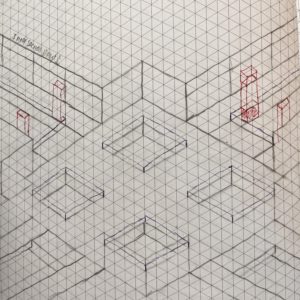
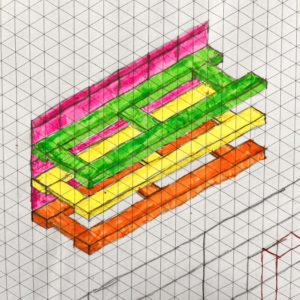
Once the base environment was created, the next step was to start modelling assets to populate the environment and to begin developing the scene to work in VR. I undertook these steps simultaneously and they are the area in which development was halted. I had many compatibility issues when trying to get my headset to work with Unreal Engine 5. I extensively troubleshooted the issue by myself and with others’ assistance, but the problem never reared its head.
When working in 3DS Max, I was initially finding it satisfactory. I was able to apply the principles I have learned in other software like Blender to develop an intermediate ability. Although I was still aware of modelling strategies and principles, the change in software meant that all utilities are located in a different places in the UI, significantly slowing the speed at which I was making progress. It meant that if I ran into an issue, it would take me far longer to troubleshoot it due to less familiarity with the software. There came a time in the development of this project when I realised that a working prototype was not feasible and a pre-rendered video was more appropriate. I knew it was a good idea to use Blender’s animation features to achieve this due to my familiarity with it, so it also made sense to fully switch to Blender to finish modelling too.
Adapting to a Concept Video
After moving to Blender, I was able to import the scene from the Unreal Engine and improve and optimise my models, and finally move them all into a scene together. This mall environment was supposed to represent just one style of many that the user would be able to choose from. For this style, I decided to go with a modern contemporary aesthetic. The plain white surfaces have a subtle bronze hue to them which makes them fit well with the brown/orange marble tile floor in the centre and the bronze-tinted glass. To provide some contrast to this, the floor of the corridors are a blackish marble with white veins running through them.
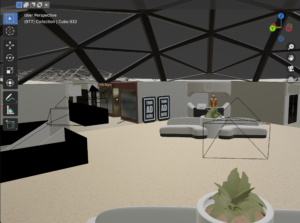
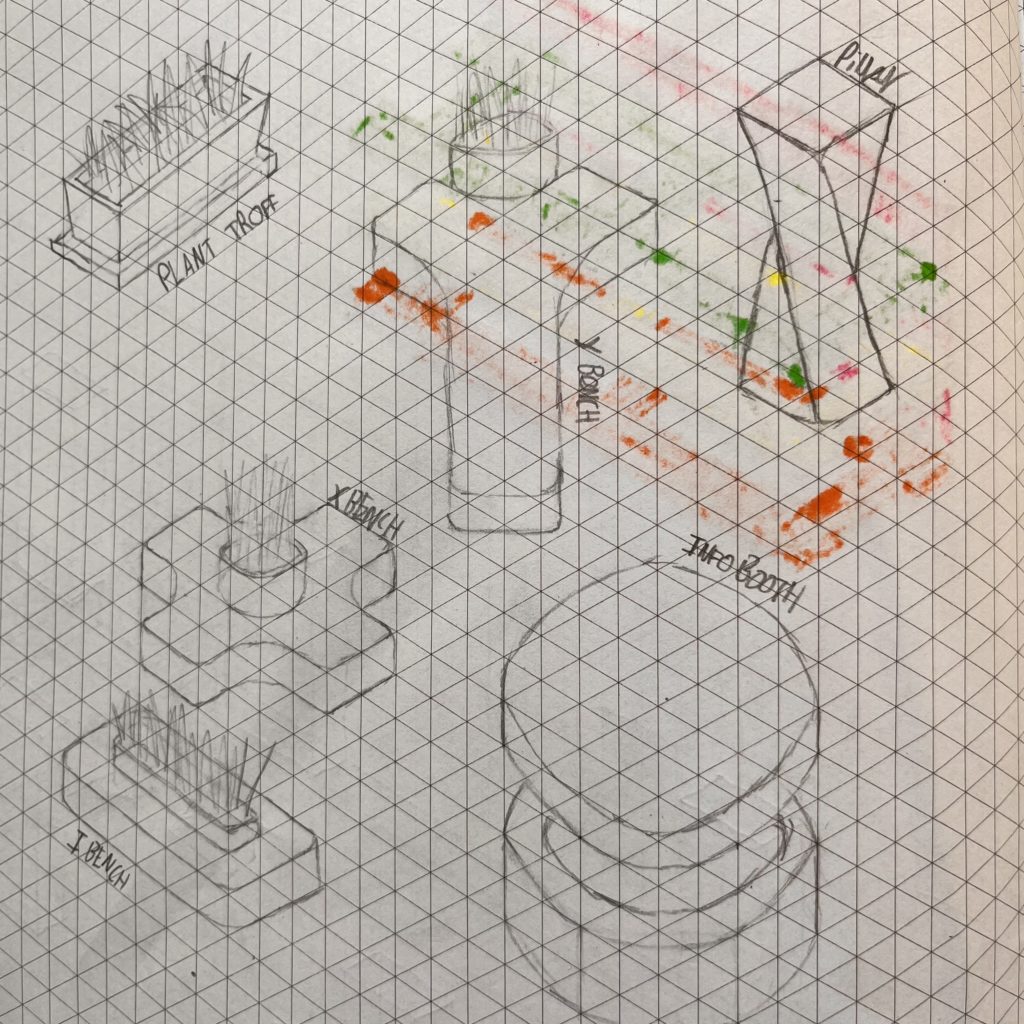
The furniture that was used in the scene is as follows; the “y-bench”, the “x-bench”, the trough plant, the steps, the information desk, and the ad space. I began developing these models by first sketching them on isometric paper and then allowing them to evolve throughout development. Once I was in Blender, I was more confident in my ability to optimise for VR. Most models were already suitable like the ad space for example, and others like the seating models allowed me to dissolve many edge loops whilst not warping the geometry to a noticeable degree. I also intend to perform a re-topology on some models like the AI assistant going forward.
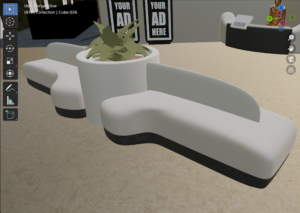
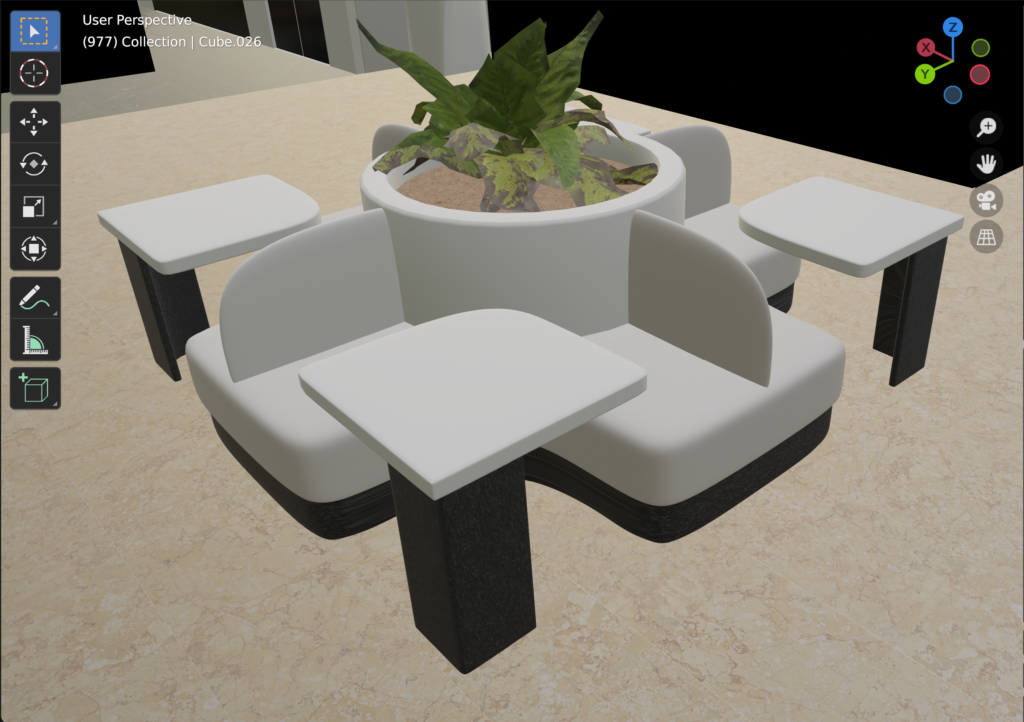
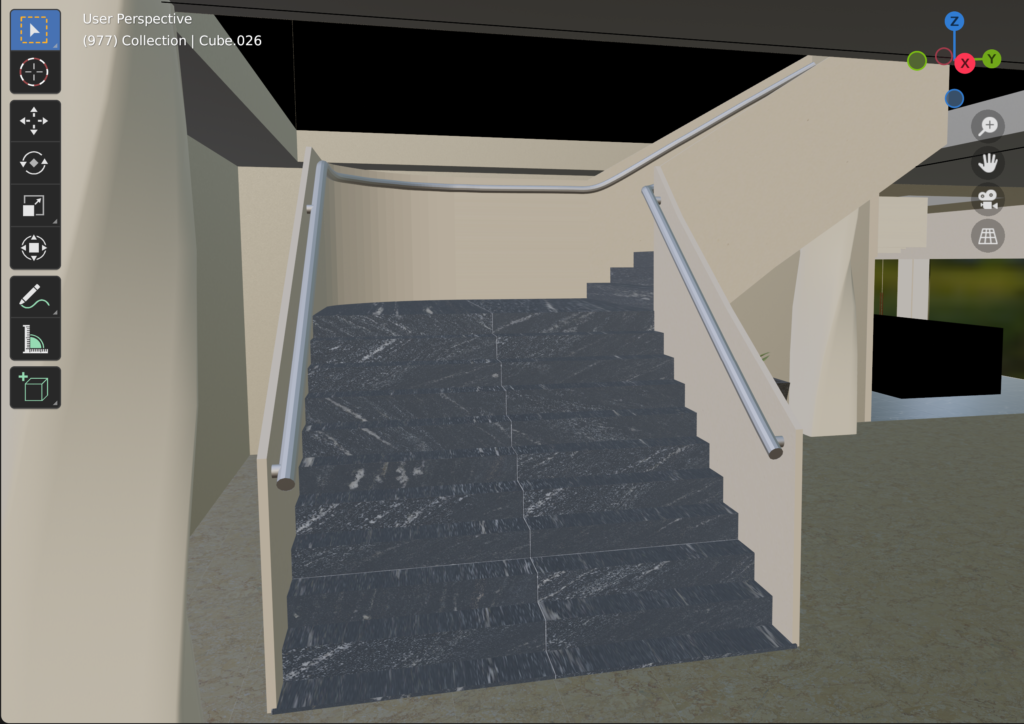
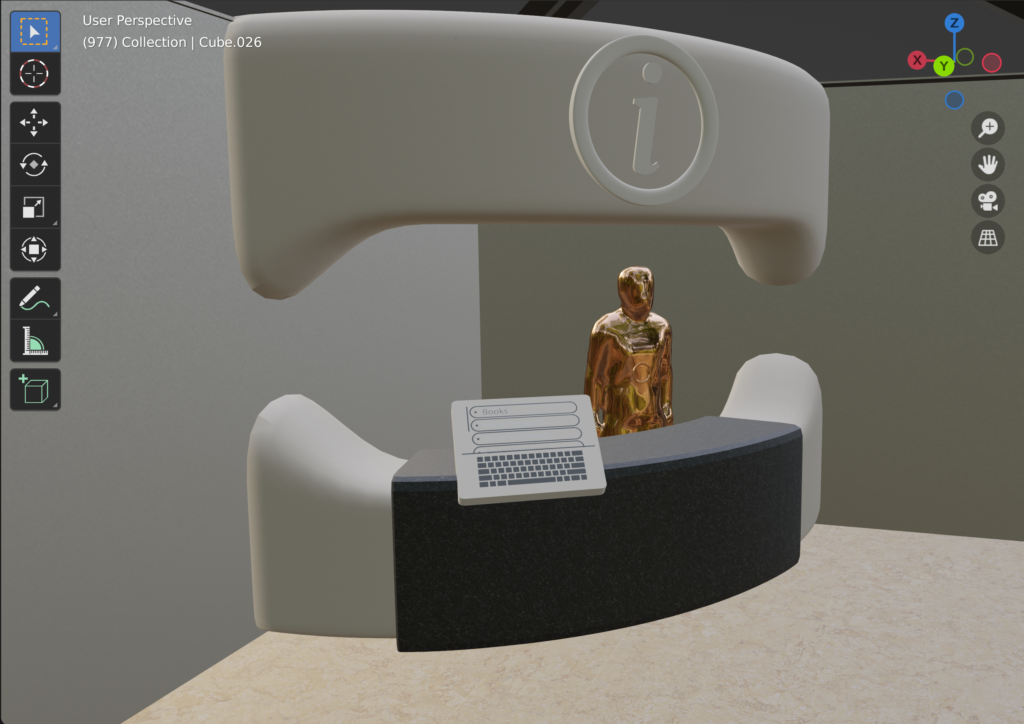
The shop exterior and shop front counter were modelled from scratch by me but all other models on the interior of the bookshop are sourced from Quixel Megascans. The bookshop’s interior is laid out to resemble a physical bookstore and to also incorporate multiple ways of displaying products like showcasing products through the front of the store, showcasing large amounts of products on the bookshelves lining the walls, and “spotlight” areas like the table or the stand where the shop owner would display items they wanted to highlight.
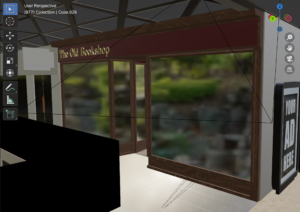
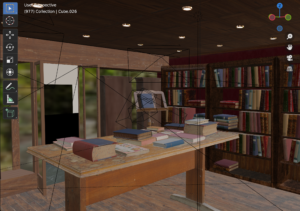
Since my goal was to create a working prototype, the concept animation needed to resemble the first-person perspective of someone exploring this environment. I achieved this by using the “walk” view type whilst placing the camera’s key frames, keeping the camera roughly 6 feet off any surfaces it is “walking” on. I also made sure to include subtle head movements where the user may have noticed something out of the corner of their eye and quickly adjusted the view to see it.
Sustainability
This project directly addresses sustainable development goal 10 as it aims to aid independent stores specifically with a fair approach. Traditional eCommerce stores like Amazon work in opposition to independent physical stores whereas VirtuMall aims to work in partnership with them. Target 10.3 says “Ensure equal opportunity and reduce inequalities of outcome, including by eliminating discriminatory laws, policies and practices and promoting appropriate legislation, policies and action in this regard” and target 10.1 aims to “progressively achieve and sustain income growth of the bottom 40 per cent of the population at a rate higher than the national average”. VirtuMall aims to provide the opportunity to run a 3D shop environment for all shops, regardless of their scale or influence and to provide a platform where they can grow.
Reflection
Finally, to reflect on the concept, I’ve conducted a SWOT analysis. I have identified the strengths of utilising an untapped market and allowing retailers to project their personality and more effectively provoke positive emotional responses. As well as this, the weaknesses include being less efficient than competitors and the possibility that retailers may not want to adapt to an alternate approach. The opportunities are that the rise of WEB 3.0 will provide an increased interest and increased accessibility for VR. And the threats are that VR doesn’t become mainstream and the risk of sharing the market with industry giants like eBay and Amazon.
To reflect on development, when considering all the issues I had to overcome, I am happy with the result. I think it was a wise decision to switch to a concept video as had I not, I may have not had an end product to present. I felt comfortable beginning to learn in 3DS Max and Unreal Engine 5 but I didn’t allow myself enough time to learn the software fully. If I were to start the project again, I would use Blender instead of 3DS Max from the start, allowing myself more time to build my skills in Unreal Engine 5. Moving forward, due to my passion for this project, I am going to continue optimising the models and developing the prototype. I look forward to moving back to the 3DS Max and Unreal Engine 5 workflow now that I have more time to develop my skills without a deadline.
